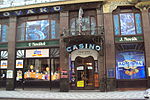St. Longin's Rotunda

St. Longin's Rotunda (Prague, Na Rybníčku) is one of the few preserved romanesque rotundas in Prague. It was founded in the 12th century as a parish church for a village "Rybníček" which was there before the founding of the Prague New Town in the middle of the 14th century. Originally, it was a Pagan temple before the arrival of Christianity, when it was transformed into a Catholic chapel. Up until the 14th century, it was consecrated to St Stephen, before Charles IV founded the New Town and changed the consecration to St Longinus, who was one of the men who took part in Jesus' crucifixion, and supposedly pierced the side of Jesus. Charles IV came to deeply regretted this action, causing him to desert the army and become a hermit, later leading to his arrest and execution. The rotunda was nearly demolished in the 19th century while the nearby street (Na Rybníčku) was being built, but fortunately it was saved by František Palacký.
Excerpt from the Wikipedia article St. Longin's Rotunda (License: CC BY-SA 3.0, Authors, Images).St. Longin's Rotunda
Na Rybníčku, Prague New Town
Geographical coordinates (GPS) Address Website External links Nearby Places Show on map
Geographical coordinates (GPS)
| Latitude | Longitude |
|---|---|
| N 50.0765 ° | E 14.4256 ° |
Address
svatý Longin
Na Rybníčku
111 21 Prague, New Town
Prague, Czechia
Open on Google Maps









